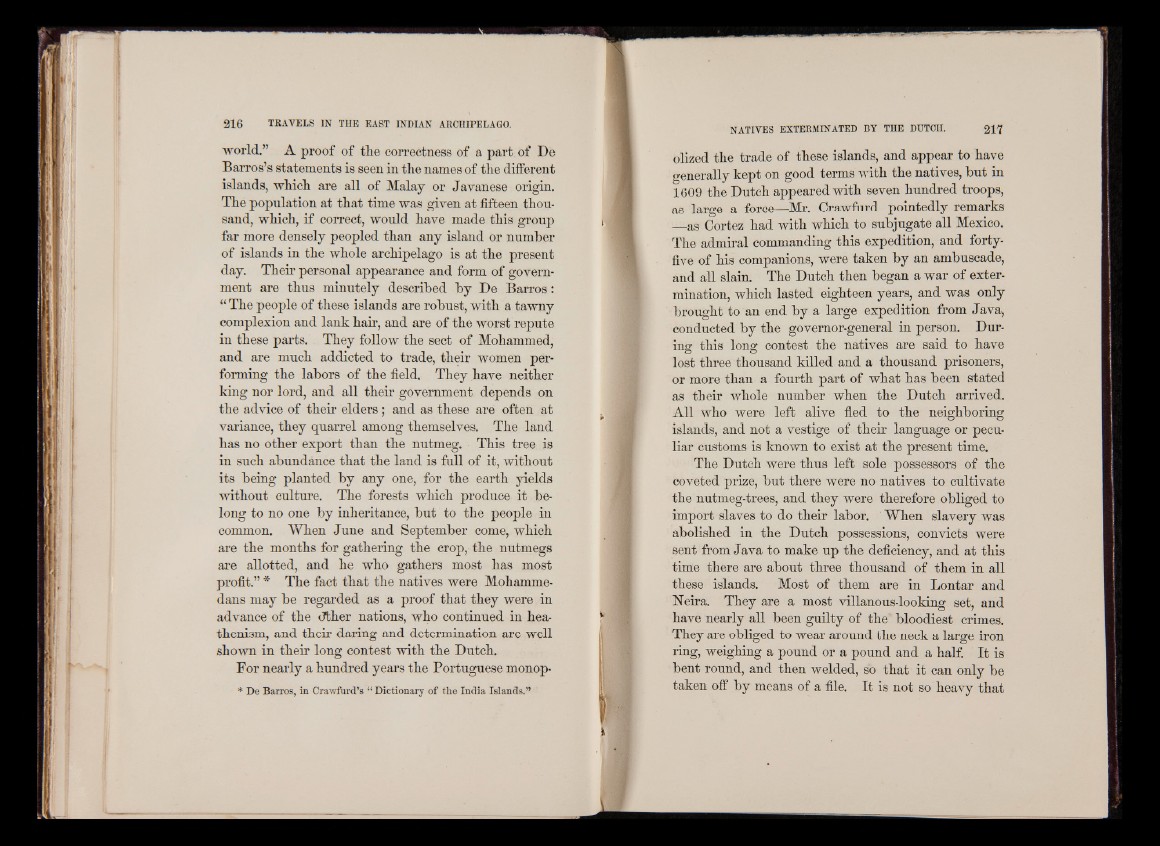
world.” A proof of the correctness of a part of De
Barros’s statements is seen in the names of the different
islands, which are all of Malay or Javanese origin.
The population at that time was given at fifteen thousand,
which, if correct, would have made this group
far more densely peopled than any island or number
of islands in the whole archipelago is at the present
day. Their personal appearance and form of government
are thus minutely described by De Barros:
“ The people of these islands are robust, with a tawny
complexion and lank hair, and are of the worst repute
in these parts. They follow the sect of Mohammed,
and are much addicted to trade, their women performing
the labors of the field. They have neither
king nor lord, and all their government depends on
the advice of their elders; and as these are often at
variance, they quarrel among themselves. The land
has no other export than the nutmeg. This tree is
in such abundance that the land is full of it, without
its being planted by any one, for the earth yields
without culture. The forests which produce it belong
to no one by inheritance, but to the people in
common. When June and September come, which
are the months for gathering the crop, the nutmegs
are allotted, and he who gathers most has most
profit.” * The fact that the natives were Mohammedans
may be regarded as a proof that they were in
advance of the Other nations, who continued in heathenism,
and their daring and determination are well
shown in their long contest with the Dutch.
For nearly a hundred years the Portuguese monop-
* De Barros, in Crawfurd’s “ Dictionary of the India Islands.”
olized the trade of these islands, and appear to have
generally kept on good terms with the natives, but in
1609 the Dutch appeared with seven hundred troops,
as large a force—Mr. Crawford pointedly remarks
—as Cortez had with which to subjugate all Mexico.
The admiral commanding this expedition, and forty-
five of his companions, were taken by an ambuscade,
and all slain. The Dutch then began a war of extermination,
which lasted eighteen years, and was only
brought to an end by a large expedition from Java,
conducted by the governor-general in person. During
this long contest the natives are said to have
lost three thousand killed and a thousand prisoners,
or more than a fourth part of what has been stated
as their whole number when the Dutch arrived.
All who were left alive fled to the neighboring
islands, and not a vestige of their language or peculiar
customs is known to exist at the present time.
The Dutch were thus left sole possessors of the
coveted prize, but there were no natives to cultivate
the nutmeg-trees, and they were therefore obliged to
import slaves to do their labor. When slavery was
abolished in the Dutch possessions, convicts were
sent from Java to make up the deficiency, and at this
time there are about three thousand of them in all
these islands. Most of them are in Lontar and
Neira. They are a most villanous-looking set, and
have nearly all been guilty of the' bloodiest crimes.
They are obliged to wear around the neck a large iron
ring, weighing a pound or a pound and a half. It is
bent round, and then welded, so that it can only be
taken off by means of a file. It is not so heavy that